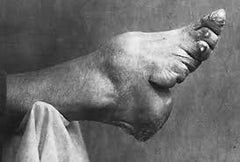THE MOTHERLOAD (Part 1): Pregnancy Foot Facts Revealed

Are your pre-pregnancy kicks feeling a little too snug? Do you feel that your belly isn’t the only thing that has grown since you have become pregnant? Here are 3 reasons why you just might be right!
JUST RELAX(IN) (1st Trimester)
The falling of the arches in your feet during pregnancy are often the result of rising hormone levels. During the 1st trimester, the body sees a spike in the hormone relaxin. To help prepare the body for childbirth, relaxin widens the cervix and relaxes the pelvic ligaments. But did you know that relaxin also makes the ligaments in your feet more lax? That’s right! Lax ligaments in your feet cause your arches to collapse, and your feet to become flatter, wider, and longer. On average, the feet can become a ½ - 1 size longer during pregnancy, and often times never return to their original sizes once pregnancy has ended.
WEIGHT FOR IT… (2nd-3rd Trimester)
With the average pregnancy adding 30-40 pounds, the feet are often subject to undergoing some of the most radical of changes in the body. Increased weight gain- specifically in the belly region- redistributes a woman’s center of gravity, causing more stress on the inner knees & lower back which in turn, causes more stress on the medial parts of the feet. As a result, the arches of the feet collapse, causing the feet turn inward (pronate) when walking. Flatfeet with increased weight places added stress on the feet making achy feet and heel pain- ie plantar fasciitis- far more prevalent. In extreme cases, added weight during pregnancy can add extra layers of fat to the soles of the feet, creating issues with fitting shoes.
UNDER PRESSURE (2nd-3rd Trimester)
Swollen feet are a complaint that is all too common among women approaching motherhood. This is largely due to the fact that as a woman becomes pregnant, her uterus grows larger increasing the pressure on the veins/vessels that return blood from the legs & feet. The slowed blood circulation in the legs & feet results in increased fluid retention- hence the swollen feet. If not carefully monitored, a mother-to-be can be at risk of pregnancy induced hypertension (preeclampsia)- which if detected should be treated by your doctor immediately.
Stay tuned for Part 2 of The Motherload, where we go inside what features expecting mothers should look for when on the hunt for the right shoe!
Putting your best FEET forward,
SH
The Lowdown on Lou Gehrig's Disease

Known as the Iron Horse, Lou Gehrig was long viewed as an accomplished first basemen for the New York Yankees who most notably playing in 2130 consecutive games- spanning 13 years. But while he personified strength and endurance on the baseball diamond, it was with great irony that a figure of this magnitude would become the face and bring worldwide attention to such a debilitating condition. But: What exactly is Lou Gehrig’s Disease? you ask. Look no further!
What is it: Also known as Amyotrophic Lateral Sclerosis (ALS), it is a progressive neurodegenerative disease. What does that mean? It’s a condition that affects the nerves that extend from the brain and spinal cord. Those nerves control muscle movement/function and as they die off, cause muscles to weaken, eventually leading to complete muscle paralysis. ALS is currently 100% fatal typically 2-5 years after onset.
Who is most likely affected: Men are more prevalent than women by a ratio of 2:1. Military veterans are twice as susceptible as the general population.
Where does it strike: Commonly starts in the hands, but extends to the arms, legs and feet.
When does it occur: Individuals in their 40’s are at the highest risk.
Why does it occur: Despite continued research, the cause is not yet known.
What the foot!?!: Those with nerve degeneration of the legs and feet, loses the ability to properly lift and plant their feet when walking in a condition known as drop foot. The nerves and muscles no longer work in tandem and causes an outward swinging of the leg and feet showing an abnormal gait. Check out this video (courtesy of YouTube) showing a gait with drop foot vs. a normal gait
Like to learn more about ALS? check out!
Putting your best FEET forward,
SH
Hit the Road

Springtime means sunshine, flowers blooming, birds chirping, and the arrival of marathon season. But as you gear up for your treacherous trek, do your running shoes have what it takes to go the distance? We gotcha covered!

It’ll Be All Light
Any long distance runner should always look to wear running shoes that are lightweight in nature. Shoes that are less bulky means that your legs and feet are carrying less weight, which improves a runner’s endurance during extensive runs.
A Soft Landing
Great shock absorption in your midsole and heel will keep your feet primed and ready for running. The impact of your feet as your heel strikes and plants into the ground can be up to 3 times your body weight. Factor in up to 26.2 miles of running and your feet are subject to a serious pounding.
Law of A-Traction
A long-lasting outsole gives you the best opportunity to stay upright as you march to the finish line. The outsole provides traction against rough surfaces- like dirt and pavement- to prevent cases of slip and fall. In addition, the outsole determines the flexibility of your running shoe. A proper outsole should allow your running shoe to bend ONLY at the ball of the foot.
Putting you best FEET forward,
SH
Show Me Your Sole
Hillary Clinton was delivering a speech at the Institute of Scrap Recycling Industries meeting today at the Mandalay Bay Hotel-Casino in Las Vegas when a disgruntled unidentified woman was taken into custody after hurling a shoe at the former US Secretary of State. Hillary WAS able to sidestep the oncoming “kick.”
What does shoe throwing mean, you ask?....
FOOT FACT:
Shoe throwing is an offensive gesture native to Middle Eastern culture. Simply put, your shoes touch all the filth on the ground. By throwing your shoe at someone, you are “throwing dirt at that person,” the ultimate sign of disrespect. To take it a step further, the poor often could not afford shoes, exposing their feet to the filth of the ground, while the wealthy wore shoes (protecting their feet from the dirt). Exposure to the dirt and filth signified a lack of class and intellect.
Putting you best FEET forward,
SH
Function vs Fashion
Visit NBCNews.com for breaking news, world news, and news about the economy
Check out these shoes you can use for all outdoor activities this Spring! Video courtesy of The Today Show.
Putting your best FEET forward,
SH
Why You Need To Walk 10,000 Steps Per Day
Spring time is around the corner (good riddance polar vortex). That means getting out, enjoying the warm sunshine, and most of all...BEING ACTIVE! Don't just take our word for it, check out this video, courtesy of MSN Video.
Putting your best FEET forward,
SH
Dude Looks like A Lady!...or Does He?
Dude (Louis XIV)


Ladies

FOOT FACT:
High heels have long been a staple of style for women, but did you know that high heel shoes were originally designed to be worn by men? In fact, the heel of the shoe helped secure men’s feet in stirrups while riding horses. High heel shoes also served as a status of privilege. Those who did not have to perform manual labor or walk very far often sported their “elevated kicks” as a symbol of their high social class. As high heels continued to grow in popularity, they would become a unisex trend, until they were abandoned by men and solely worn by women.
Putting you best FEET forward,
SH
No Pain, No Reign


FOOT FACT:
FOOT BINDING was an ancient Chinese custom among women that dates back to the 10th century. The practice began as a ritual among Chinese royalty but would later become widespread as a status symbol among wealthy women who wished to become married. The idea was that women who had their feet bound endured the painful process, because they had the privilege of not having to work.

Poor women were not considered worthy of the ritual, because they needed their feet to remain normal to work to care for their families. Foot binding would remain a common practice in Chinese culture until the 19th century, where Western culture would influence its removal from society.
Putting you best FEET forward,
SH






